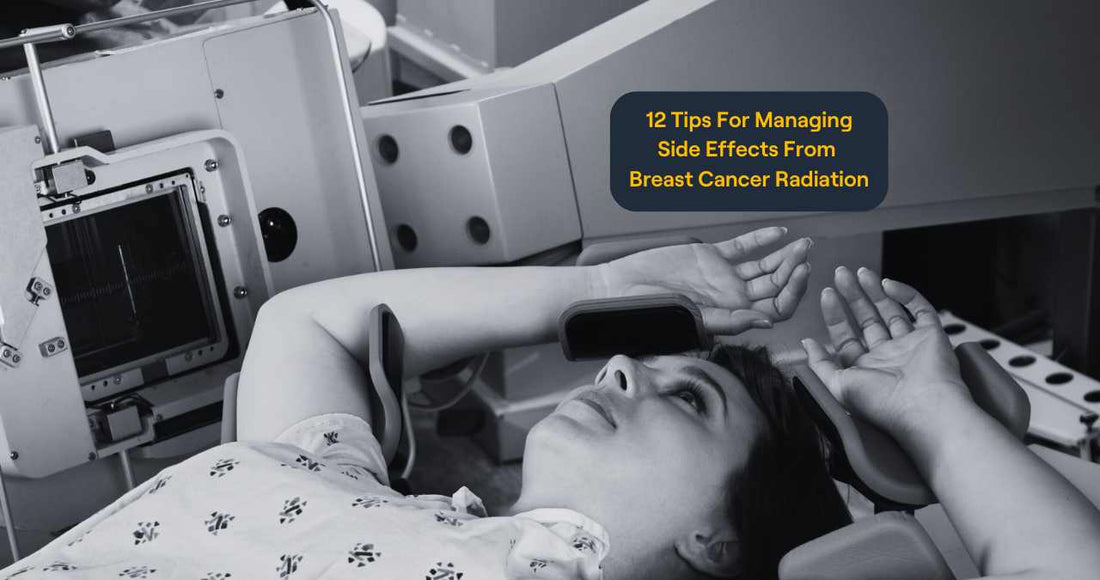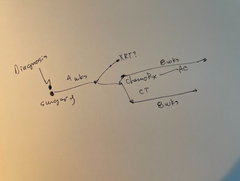Author: Molly Lindquist
Medically reviewed by Dr. Douglas Blayney August 12, 2024.
Introduction to Breast Cancer Radiation
Breast cancer radiation therapy is a cornerstone in the treatment of breast cancer, often employed after surgery to eliminate any remaining cancer cells and reduce the risk of recurrence. This therapy uses high-energy rays or particles to target and destroy cancerous tissues in the breast, chest wall, or surrounding lymph nodes. Radiation therapy is also used to reduce symptoms from cancer metastases. For example, if the cancer recurs or comes back and involves the bones, radiation therapy is very effective in reducing pain. While highly effective, radiation therapy can also lead to various side effects, ranging from mild skin irritation to more severe complications such as fatigue, breast pain, and lymphedema.
Managing these side effects is crucial for the overall well-being of patients undergoing breast cancer radiation therapy. Effective management strategies can significantly improve quality of life, allowing patients to maintain their physical, emotional, and social functioning during and after treatment. By addressing side effects proactively, healthcare providers can help patients complete their therapy with fewer disruptions and better outcomes, ultimately enhancing both short-term recovery and long-term health.
Side Effects of Radiation Therapy
Short-term Side Effects of Radiation Therapy for Breast Cancer Treatment
Radiation therapy is a common and effective treatment for breast cancer, but it can cause several short-term side effects. Understanding these side effects helps patients and caregivers better manage and mitigate their impact on daily life. Some of the most common short-term side effects include:
1. Pain and Skin Changes
One of the primary short-term side effects of radiation therapy is pain and changes to the skin in the treated area. The high-energy rays can irritate the skin, causing redness, itching, dryness, and peeling, similar to a sunburn. This condition is often referred to as radiation dermatitis. The skin may become sensitive, leading to discomfort or pain, particularly when touched or moved. In some cases, small blisters or moist, weepy areas can develop, requiring careful cleaning and protection to prevent infection and promote healing. These skin changes usually begin a few weeks into treatment and can persist for several weeks after the therapy has concluded.
2. Fatigue
Fatigue is another common short-term side effect of radiation therapy. Unlike typical tiredness, this fatigue can be intense and persistent, not necessarily improving with rest. Patients may feel extremely exhausted, weak, and lacking in energy, which can interfere with daily activities and reduce the quality of life. The fatigue usually starts well into the treatment course, and may persist for weeks after the treatment is completed. The exact cause of radiation-induced fatigue is not fully understood but is thought to be due to the body's efforts to repair the damage caused by radiation and the overall stress of undergoing cancer treatment. Managing fatigue involves balancing rest with light physical activity, maintaining good nutrition, and seeking support from healthcare providers, family, and friends.
Long-term Side Effects of Radiation Therapy for Breast Cancer Treatment
Radiation therapy is a powerful tool in the fight against breast cancer, often essential for reducing the risk of recurrence. However, while it can be highly effective, it may also lead to long-term side effects. These effects can emerge months or even years after the completion of treatment and can impact a patient's quality of life. Understanding these potential long-term side effects allows patients and their healthcare providers to monitor and manage them effectively.
1. Skin Changes
Long-term skin changes are a common consequence of radiation therapy. The treated area may develop permanent pigmentation changes, resulting in skin that appears darker or lighter than the surrounding areas. Additionally, the skin might become more fragile or thinner, making it more susceptible to injury or bruising. Scar tissue can also form, leading to firmness or tightness in the breast or chest area. Finally, after several years, small blood vessels (arterioles) may become visible on the skin in areas where high radiation doses were used.
2. Breast Tissue Changes
Radiation can cause changes in the texture and appearance of the breast tissue. The treated breast might become firmer or smaller over time due to fibrosis, a condition where the tissue becomes thickened and less elastic. These changes can affect the symmetry and overall appearance of the breasts.
3. Lymphedema
Lymphedema is a condition characterized by swelling, typically in the arm, due to the accumulation of lymph fluid. This can occur if the lymph nodes under the arm are included in the radiation treatment. Lymphedema can develop months or years after therapy and may be long lasting. Removal of many lymph nodes at the time of surgery, and then undergoing radiation to that area can increase the risk of lymphedema. Managing this condition involves physical therapy, compression garments, and exercises to improve lymphatic drainage and reduce swelling. According to Cancer Research UK, 1 in 5 breast cancer patients develop lymphedema of the arm following radiation therapy or surgical treatment to remove lymph nodes.
When to contact your radiation oncologist and team
Development of new lumps, either in the area of the breast which has received radiation or elsewhere, is a reason to seek help from your oncology team. Also, areas of the skin with ulceration (that is areas of skin which are weeping fluid or bleeding or appears as if it has been burned) are reasons to seek help.
Rare Short-term Side Effects of Radiation Therapy for Breast Cancer
1. Nausea
Nausea is an uncommon short-term side effect of radiation therapy for breast cancer. While more typically associated with chemotherapy, some patients may experience nausea during radiation treatment. This can occur due to the body's overall response to the stress of cancer therapy. Managing nausea involves dietary adjustments, such as eating small, frequent meals, staying hydrated, and avoiding foods that can trigger nausea. Additionally, medications prescribed by healthcare providers can help control this symptom, ensuring patients maintain proper nutrition and comfort during treatment.
2. Hair Loss
Hair loss, although rare in breast cancer radiation therapy, can occur in the specific areas where radiation is applied. For example, if the lymph nodes under the arm are included in the treatment field, hair loss in the armpit area may result. This type of hair loss is typically localized and does not affect the scalp. According to Cancer Research UK, hair typically grows back 6+ months following radiation therapy. Higher doses of radiation are directly correlated with a longer time before hair regrows, and it is rare but possible that hair might not grow back. Patients should discuss concerns about hair loss with their healthcare team to receive appropriate advice and support.
Rare Long-term Side Effects of Radiation Therapy for Breast Cancer
1. Rib Fracture
Radiation therapy can weaken the ribs in the treated area, making them more susceptible to fractures. This is particularly true for patients who receive high doses of radiation. Rib fractures can occur with minimal trauma and may cause pain and discomfort. These fractures require careful management to ensure proper healing and to prevent further complications.
2. Heart Problems
Radiation therapy, especially when targeting the left breast, can increase the risk of heart problems. Ask your radiation therapy team healthcare provider about the likelihood of heart damage with your specific treatment plan, and if there are alternative treatment methods or plans.This can include conditions such as coronary artery disease, heart attacks, and pericarditis (inflammation of the sac surrounding the heart). These heart issues may develop slowly over time and can have significant impacts on a patient’s overall health. Regular monitoring and preventive measures are essential to manage these risks.
3. Lung Problems
Radiation therapy can also affect the lungs, particularly if the treatment field includes the chest area. Ask your radiation therapy team healthcare provider about the likelihood of lung damage with your specific treatment plan, and if there are alternative treatment methods or plans. Long-term side effects may include reduced lung capacity, lung fibrosis (scarring and thickening of lung tissue), and radiation pneumonitis (inflammation of the lung). These conditions can lead to breathing difficulties and reduced quality of life. Managing lung problems often involves pulmonary rehabilitation, medications, and lifestyle modifications to improve lung function.
4. Nerve Problems
Radiation therapy can rarely cause long-term nerve damage, leading to a condition called brachial plexopathy. This condition affects the nerves in the shoulder, arm, and hand, resulting in pain, numbness, and weakness. These symptoms can impact daily activities and overall functionality. Physical therapy, pain management strategies, and occupational therapy can help manage nerve problems and improve the quality of life for affected patients.
Will side effects limit my activities?
Radiation therapy side effects can temporarily limit your activities, but many people continue their daily routines with adjustments. Fatigue, for instance, might make you feel more tired than usual, leading you to rest more. Skin changes and pain might restrict certain physical activities. However, staying moderately active can help manage some side effects. It's important to listen to your body and consult your healthcare team for personalized advice on balancing rest and activity during treatment.
Why do I feel fatigued?
Fatigue is a common side effect of radiation therapy, especially for breast cancer. Several factors contribute to this feeling of exhaustion:
- Energy Expenditure: Radiation therapy targets cancer cells, but it can also affect surrounding healthy tissues. Your body expends extra energy to repair and heal these tissues, which can lead to fatigue.
- Cumulative Effect: The fatigue often builds up over time. The more radiation treatments you receive, the more your body needs to rest and recover.
- Emotional Stress: Undergoing cancer treatment can be emotionally draining. The stress and anxiety associated with the treatment process can contribute to feelings of fatigue.
- Disruption of Normal Routine: The time and effort involved in attending appointments, managing side effects, and adjusting to changes in your body can also contribute to a sense of exhaustion.
- Overall Health: Your general health and fitness level, as well as how well you’re managing side effects and maintaining nutrition and hydration, can impact your energy levels.
Some ways you can reduce fatigue on your own include exercising regularly, eating healthy, and sleeping/resting.
How to manage skin side effects of radiation therapy
Managing skin side effects from radiation therapy is important for maintaining comfort and promoting healing. Here are some strategies to help you care for your skin:
- Follow Instructions: Adhere to any specific skincare instructions given by your radiation oncologist or nurse.
- Keep the Area Clean: Gently cleanse the treated area with lukewarm water and a mild, fragrance-free soap. Avoid scrubbing or using rough washcloths.
- Moisturize Regularly: Apply a gentle, fragrance-free moisturizer to the treated area. This helps keep the skin hydrated and can reduce dryness and itching. Some patients find products with aloe vera or other soothing ingredients beneficial, but it’s best to consult your healthcare team about which products are safe for you.
- Avoid Irritants: Refrain from using products with alcohol, perfume, or dyes on the treated area, as these can irritate the skin.
- Wear Loose Clothing: Choose soft, breathable fabrics and avoid tight or abrasive clothing over the treated area.
- Protect from Sun Exposure: Keep the treated area covered or use a sunscreen with a high SPF to protect it from the sun’s UV rays. Radiation-damaged skin is more sensitive to sunburn.
- Avoid Heat and Cold: Try to avoid exposing the area to extreme temperatures, such as hot packs or ice packs, which can exacerbate irritation.
- Stay Hydrated: Drink plenty of water to help keep your skin hydrated from the inside out.
- Use a Humidifier: If the air in your home is dry, using a humidifier can help keep your skin from becoming too dry.
- Monitor for Changes: Keep an eye on your skin for any changes or worsening of symptoms and report them to your healthcare provider. They may adjust your treatment plan or recommend additional skincare measures.
How can I prevent hair loss?
Hair loss from radiation therapy can be challenging, but there are some strategies you might consider to help manage or reduce it:
- Consult Your Oncologist: Ask your radiation therapy team about the likelihood of hair loss with your specific treatment plan, and if there are alternative treatment methods or plans. They can provide tailored advice and discuss potential options.
- Scalp Cooling: Scalp cooling systems, like cold caps, can sometimes reduce hair loss by cooling the scalp and narrowing blood vessels, which may decrease the amount of chemotherapy drugs reaching the hair follicles. While this is more commonly used for chemotherapy, ask if there are similar options for radiation therapy in your case.
- Gentle Hair Care: Use a mild, sulfate-free shampoo and conditioner. Avoid harsh treatments like perming, coloring, or excessive heat styling, as these can damage hair and make it more prone to falling out.
- Avoid Tight Hairstyles: Avoid hairstyles that pull on the hair, such as tight ponytails or braids, which can cause additional stress on the hair follicles.
- Minimize Heat and Chemical Exposure: Reduce the use of hair dryers, curling irons, and straighteners. If you use these tools, keep the heat settings low and use protective products.
- Protect Your Scalp: If you do experience hair loss, protect your scalp from the sun and cold weather. Wear a hat, scarf, or sunscreen designed for the scalp.
- Consider a Wig or Head Covering: If hair loss occurs, you might want to explore wigs, hats, or scarves as options to help you feel more comfortable.
- Healthy Diet: Maintain a balanced diet rich in vitamins and minerals that support hair health. Consult a nutritionist if you have specific dietary concerns.
Hair regrowth typically begins once radiation therapy is completed, though it may take several months to a year for hair to return to its normal state.
What side effects occur with radiation therapy to the breast and chest?
- Skin Changes: Redness, dryness, itching, or peeling in the treated area. Skin may become sensitive and sore.
- Fatigue: General tiredness and exhaustion are common, especially as treatment progresses.
- Pain or Discomfort: Some patients experience soreness or a feeling of heaviness in the breast or chest area.
- Swelling: Lymphedema or swelling in the breast or surrounding areas can occur.
- Changes in Skin Texture: The skin may become thicker or dimpled in the treated area.
- Altered Sensation: Some may experience numbness or a change in sensation in the treated area.
- Radiation Pneumonitis: In rare cases, inflammation of the lung tissue near the treated area can occur, causing symptoms like cough, shortness of breath, or chest pain.
What side effects occur with radiation therapy to the stomach and abdomen?
- Nausea and Vomiting: This can occur due to radiation affecting the stomach or intestines.
- Diarrhea: Irritation of the intestines can lead to diarrhea.
- Abdominal Pain: Cramping or discomfort in the abdomen may occur.
- Appetite Loss: Reduced appetite or changes in taste can affect eating habits.
- Fatigue: General tiredness and weakness are common.
- Skin Irritation: Similar to breast and chest radiation, skin in the abdominal area may become irritated or sensitive.
- Increased Risk of Infection: The radiation can affect the gastrointestinal tract's ability to function normally, potentially increasing infection risk.
What side effects occur with radiation therapy to the pelvis?
- Urinary Issues: Radiation to the pelvis can cause increased frequency, urgency, or discomfort when urinating. Some patients might experience blood in the urine.
- Gastrointestinal Symptoms: Nausea, vomiting, diarrhea, or abdominal cramping are possible due to effects on the intestines.
- Skin Changes: Irritation or redness in the pelvic area, including the groin and buttocks.
- Fatigue: Similar to other areas, overall fatigue is common.
- Fertility Issues: Radiation to the pelvic area may impact fertility, especially if ovaries or testicles are involved.
- Lymphedema: Swelling in the legs or pelvic area can occur if lymph nodes are affected.
Each person’s experience with radiation therapy can vary, and side effects depend on the specific dose and treatment area. Ask your radiation therapy team healthcare provider about the likelihood of significant long term side effects with your specific treatment plan, and if there are alternative treatment methods or plans. It’s important to communicate with your healthcare team about any side effects you experience, as they can provide support and adjust your treatment plan if necessary.
Radiation Therapy in Breast Cancer and Risk of a Second Cancer
Radiation therapy is a common treatment for breast cancer, used to eliminate any remaining cancer cells after surgery or to shrink tumors before surgery. It works by targeting high-energy rays at the cancerous area, which can destroy cancer cells and reduce the risk of recurrence.
However, while radiation therapy is effective in treating breast cancer, it carries a small risk of developing a second cancer later in life. This risk is influenced by factors such as the dose of radiation, the area treated, the patient's age, and individual genetic factors. Common second cancers associated with breast radiation include lung cancer, esophageal cancer, and sarcomas in the chest area. Regular follow-up care, a healthy lifestyle, and vigilant monitoring are important for managing this risk and ensuring early detection if a second cancer develops.
Our team “gets it”
The Manta Cares team is composed of cancer survivors, caregivers and oncologists - so we truly understand the challenges that come with a cancer diagnosis because we’ve been there. We are here to walk with you as you go through your own cancer experience. Please don’t hesitate to reach out with any questions. Be sure to subscribe to our newsletter and check out our free resources like our Chemotherapy Checklist for Caregivers, Financial Checklist for Cancer Treatment and more. We also put out a bi-weekly podcast called the Patient from Hell to educate, empower and hopefully inspire you as you go through this crappy experience. You can listen on Spotify, Apple Podcasts, YouTube or anywhere you listen to podcasts. Dealing with cancer as a patient or caregiver can feel really lonely. Just know that you are not alone in this experience.
Conclusion
Effectively managing the side effects of radiation therapy in breast cancer treatment is crucial for maintaining quality of life and supporting overall recovery. By adhering to recommended skincare routines, addressing symptoms such as fatigue and discomfort, and making lifestyle adjustments, patients can alleviate some of the common side effects. Open communication with the healthcare team, alongside regular follow-ups, ensures that any issues are promptly addressed and managed. Comprehensive care and support can help minimize the impact of side effects, enabling patients to focus on their recovery and overall well-being.
Related Articles:
- Why Do Women Lose Breast Sensation After Mastectomy?
- What breast cancer taught me about gratitude
- Updated Mammogram Screening Guidelines for Preventative Breast Cancer Screening
- Preparing for Radiation Therapy: Setting Up Your Routine
- Preparing for Radiation Therapy: Questions for Your Doctor
FAQs: Tips to Manage Breast Cancer Radiation Therapy Side-effects
Q: Does radiation therapy affect immunity?
Ans - Yes, radiation therapy can affect immunity, particularly if it targets areas with lymph nodes or bone marrow. It may lead to a temporary decrease in immune function, increasing the risk of infections.
Q: Will my appetite be affected?
Ans - Radiation therapy can affect appetite, especially if it targets the abdomen or chest. Nausea, changes in taste, or discomfort can lead to reduced food intake.
Q: What are the common side effects of breast cancer radiation therapy?
Ans - Common side effects include skin irritation (redness, dryness, itching), fatigue, localized pain or discomfort, and swelling in the breast or chest area.
Q: How can I reduce skin irritation from radiation therapy?
Ans - To reduce skin irritation, keep the area clean and moisturized with gentle, fragrance-free products. Avoid tight clothing and protect the skin from sun exposure and extreme temperatures.
Q: What should I eat during radiation therapy to help manage side effects?
Ans - Focus on a balanced diet rich in fruits, vegetables, whole grains, and lean proteins. Eating small, frequent meals can help manage nausea and maintain energy levels.
Q: How much water should I drink during radiation therapy?
Ans - Aim to drink about 8-10 cups (64-80 ounces) of water per day, or as advised by your healthcare provider, to stay hydrated and support overall health.
Q: Is it safe to exercise during radiation therapy?
Ans - Yes, light to moderate exercise is generally safe and can help manage fatigue, improve mood, and maintain physical strength. Always consult your healthcare team before starting or modifying your exercise routine.
Q: How can I manage fatigue caused by radiation therapy?
Ans - Manage fatigue by prioritizing rest, balancing activity with relaxation, maintaining a nutritious diet, and staying hydrated. Gentle exercise and stress management techniques can also help.
Q: What pain relief options are available for radiation therapy side effects?
Ans - Pain relief options include over-the-counter pain relievers (e.g., acetaminophen or ibuprofen), prescribed medications, and non-pharmacological methods like heat packs or relaxation techniques. Consult your healthcare provider for personalized recommendations.
Q: How can I manage emotional side effects during radiation therapy?
Ans - Managing emotional side effects can involve seeking support from counseling or support groups, practicing stress-relief techniques such as mindfulness or meditation, and maintaining open communication with loved ones and your healthcare team.
Disclaimer: All content and information provided in connection with Manta Cares is solely intended for informational and educational purposes only. This content and information is not intended to be a substitute for medical advice, diagnosis, or treatment. Always seek the advice of your physician or other qualified health provider with any questions you may have regarding a medical condition.






